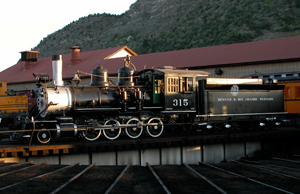National and State Register
Denver & Rio Grande Western Railroad (D&RGW) Locomotive No. 315
La Plata County
Denver & Rio Grande Western Railroad (D&RGW) Locomotive No. 315 operated for the Florence & Cripple Creek Railroad (F&CC) and the D&RGW between 1895 and 1949. From 1895 to 1912, as F&CC No. 3, the locomotive and its sister engines played a key role in the development of Colorado’s Cripple Creek Gold Mining District. The locomotive served on the all-important passenger and freight transportation link between mountain mines and valley smelters and settlements, delivering coal and supplies to an otherwise isolated mining district. D&RGW No. 315 is the oldest surviving former F&CC engine. In a second period, 1917-1941, Locomotive No. 315 served southwestern Colorado in the broader context of supporting general development through transportation. During this period trains performed as the principal long-distance haulers of freight and transporters of people. In a final period of operation, 1941-1949, Locomotive No. 315 became a switch engine in the Durango yard, saw the resurgence of passenger traffic from tourism, and participated in the first movie shot in southwestern Colorado.
The locomotive is an excellent operational example of a late 19th Consolidation-type narrow gauge steam-powered locomotive. This type of locomotive constituted a major form of motive power used to bring gold, silver, and other ore out of the mountains and to haul food and supplies to the mining communities, as well as transport coal, lumber, and agricultural products so important to the economic success of early Colorado communities. After larger, more modern and sophisticated 20th century locomotives took over the mainline narrow gauge lines, the now smaller locomotives, such as No. 315, spent two or three decades as the workhorses on the mountain branch lines. Its over half-century of operational service attests to the engineering success of No. 315’s design and construction.

